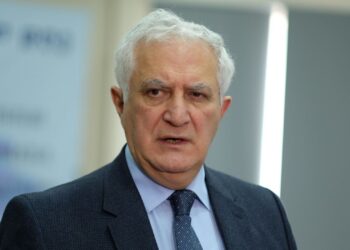Georgia’s Kakheti region is distinguished by amazingly beautiful landscapes, rich biodiversity, and unique ecological treasures. However, sadly, this natural haven faces a significant challenge – the delicate balance between maintaining a living landscape and the looming threat of desertification.
Recognizing the urgency of the situation, the Kakheti Steppes project, implemented by SABUKO, BirdLife partner, in collaboration with local communities, is working to protect biodiversity and conserve local species.
Building upon the successes of the previously funded ‘Restoring Gallery Forest and Grasslands in the Iori River Valley’ project, the Kakheti Steppes project places a strong emphasis on the restoration of wildlife habitats and fostering collaboration with the pastoralist community. “It is very important for us to involve and cooperate with local farmers. By engaging with them daily, we implement activities together and gain valuable insights from their experience as well. Over the years, their confidence in our work has grown as they see positive results, which ensures long-term benefits for nature and its restoration”, Aleksandre Mikeladze, the project manager.
Various innovative initiatives and methods are being carried out on the spot to achieve these goals.
These areas have been used as winter pastures for centuries, but due to the excessive number of sheep, the ecosystem is losing its ability to self-restore, which leads to soil erosion. That’s why quick and professional action is needed now to stop this process and save the country’s unique biodiversity.
As a result of the measures implemented by SABUKO, pasture restoration and protection of local unique species has noticeably improved.
Heavily degraded areas received targeted restoration measures, among them cutting grasses, strategically spreading manure, and employing the technique of mob grazing, aimed at stimulating plant growth and accelerating recovery. E-fences were also installed. The impact of these interventions was meticulously monitored, providing valuable insights into the effectiveness of restoration strategies.
Giorgi Chikorashvili, Natural Resource Manager at SABUKO, elaborated on the recent diligent work of SABUKO to achieve soil and ecosystem restoration on the ground.

“We implemented various combined measures,” Giorgi tells us. “We decided to install electric fences in the protected area of Chachuna, the protected area of Vashlovani and the multi-use areas of Samukhi. The process is still ongoing. Using electric fences is an eco-friendly and relatively new method in Georgia. Prior to SABUKO, almost no one in the Georgian market used electric fences, so as a result of research and learning from international experience, we became ‘pioneers’ in this field.
“Initially, we would place a flock of sheep within the fenced area, which would improve the structure of the soil surface by grazing and trampling. We would then empty the fenced area and, together with scientists and farmers, we would start working on restoring the ground by experimenting, using different methods.
“We set up six one-hectare electric fences in Chachuna Reserve, Samukhi Valley and Vashlovani and started mob grazing in them, that is, we brought a large number of sheep into the fenced area and let them graze, to prepare the ground for experimentation. After they had cultivated the area naturally with their hooves, within each one-hectare sample area, we arranged four sample sections. By May, we could clearly see the results: In the degraded area where there had been no grass, sowing and manure had led to a great result and very good grass growth. The change was easy to see even with the naked eye. Behind this result was our work, done based on scientific research and with a method proven not only in science but also in farming life. A number of countries do this to “enrich” the ground.
“In this whole process, it is very important for us to involve and cooperate with local farmers. We need their support for better results. By actively engaging with the farmers and communicating with them on a daily basis, we were able to implement all the activities together with them. They constantly monitor our activities, give us advice based on their personal experience, which is mutually beneficial, and most importantly, they are ready for novelties. We have seen great progress in this regard, because over the years, their attitude towards our work has changed: They have gained more confidence, because they themselves see these results, which bring only good and do not harm them. Of course, what concerns nature and its restoration is a long-term process and takes time, and they will see even more beneficial changes and results in a few years.”
Marinus Gebhardt, Grassland Restoration Expert at SABUKO, told us more about the testing interventions carried out by SABUKO on the ground, and their results.
“In meetings with the Agency of Protected Areas and other organizations, there was a request for technical measures to be taken to restore the pastures, especially in very degraded areas,” Gebhardt notes. “To test various measures, we tried grass cutting, organic manure spreading, and treatment with hay. At some areas, we used a combination to get results. For comparison, we left some test areas as-was. All this experimentation was done in cooperation with local stakeholders, so they could see for themselves what worked.

“Our aim is to control grazing pressure to avoid soil degradation, for which we use electric fences and mob grazing. Mob grazing means that the animals are moved frequently, so that pasture is then given a long period to rest and recover. We believe that mob grazing is a very effective measure for pasture restoration, in combination with other measures. A widely accepted practice worldwide, we were eager to try it in Georgia. Sometimes the electric fences get damaged because the animals are not used to them, but we simply need to “adapt” and make adjustments.
“The important thing is that the result inside and outside the fences is already visible, that hay and manure spreading are especially good measures for pasture renewal. The results in terms of grass restoration are quite promising. Though there have been some issues and challenges along the way, we can say that the results are positive and clear. Visual improvement is one thing, but implementation of these measures needs technique and knowledge, to which we paid a lot of attention. These measures are easily done, and stakeholders can do it themselves.
“Another mission of our team on the ground is raising awareness among local farmers in order to achieve grassland restoration through joint work. Land management measures and mob grazing were somehow an abstract concept for them, but when they see the results and improvement in practice, of course, trust and involvement increases, which makes us very happy and proud! Constant cooperation with stakeholders is really important for us to achieve sustainable results,” Gebhardt says.














